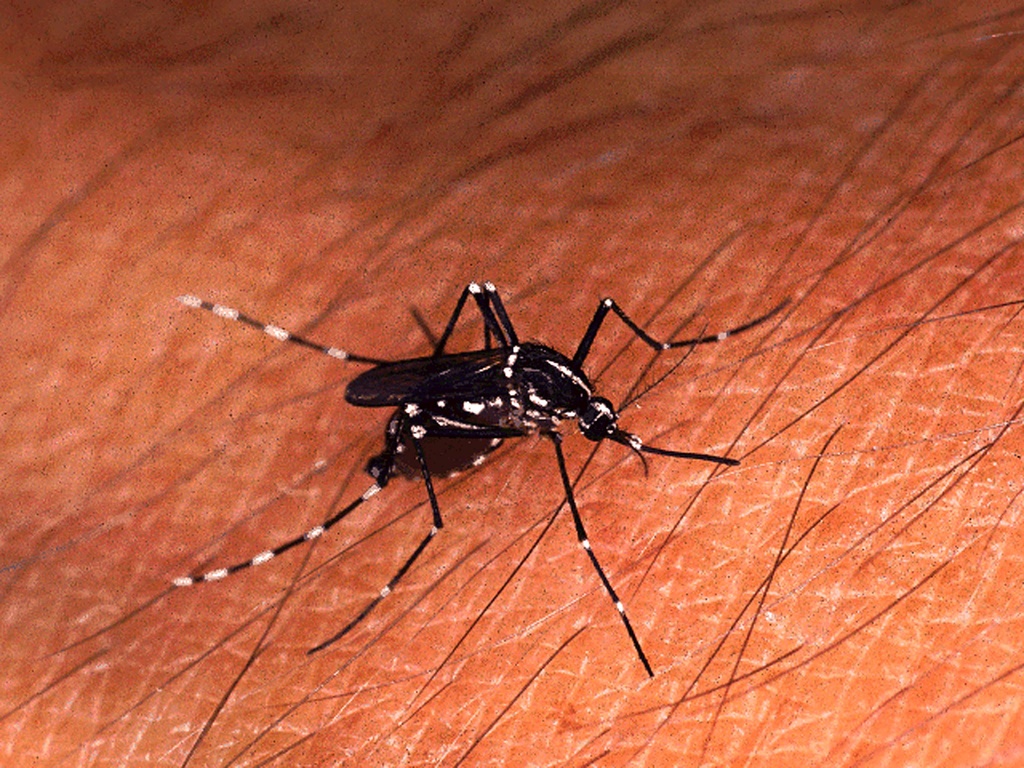Spread of the Asian tiger mosquito feared

Reports, later refuted, that the virus-carrying Asian tiger mosquito had spread north in Switzerland have highlighted the threats posed by the insect.
The mosquito is already firmly established in Ticino, in the south of the country, and authorities and experts have this summer stepped up their battle against it.
The Aargau sighting – first flagged up in the media on September 4 – has been found to be that of a “cousin” mosquito, the Aedes japonicus, said Anne-Gabrielle Wust Saucy, head of the biotechnology section of the Federal Environment Office.
“So it means that, up to now, we have not yet observed any tiger mosquito population north of the Alps,” she confirmed to swissinfo.ch.
A report in 2007, also for canton Aargau, similarly was later proved to be a false alarm.
The Asian tiger mosquito, so called because of its white and black stripy appearance, originates in Southeast Asia. It is thought to have reached Ticino eight years ago via Italy. Factors influencing its spread are car boots, the trade in used tyres and the import of exotic plants.
The highly invasive mosquito is known to be a vector of the viruses that cause the Dengue and chikungunya fevers, which are dangerous to humans, but it does not harbour malaria.
“We expect it to spread, unfortunately, but Ticino’s work fighting the mosquito is also aimed at helping to slow down its northern dispersion, ” said Wust Saucy.
Action plan
In June this year the Environment Office, along with the Federal Health Office and experts from canton Ticino, announced a Concept 2011 action plan to help cantons – both the affected and the potentially affected – battle the Asian tiger mosquito.
Long-term measures include, for example destroying its breeding areas, as well as the larvae and the adult insects.
“We are very much concerned with the risks to human health, but also the environmental problems, such as risks to the environment and other biodiversity when fighting the tiger mosquito,” explained Wust Saucy.
Doctors in Switzerland are already obliged to report any Dengue or chikungunya human infections. These cases can be checked against the location of mosquito populations to better target the control of the mosquito.
Pie Müller, head of the vector control centre at the Swiss Tropical and Public Health Institute in Basel, said that a Swiss Vector Entomology Group – of scientists and officials – had also been set up.
It is currently carrying out an Environment Office-funded survey to investigate the diversity and presence of mosquito species across Switzerland.
Challenges
He pointed out that it was, however, quite challenging to control the Asian tiger mosquito because the females lay their eggs in any kind of small water container. Several measures have to be taken together such as clearing any possible breeding sites and using insecticides.
“In Ticino they use Bacillus thuringienis israelensis (Bti), a bacteria which kills mosquito larvae,” Müller told swissinfo.ch.
“They have special traps which lure and kill the mosquitoes and they also treat sewage drainages with chemicals and Bti. They also spray against the adult mosquitoes,” he added.
Experts and the authorities are especially keen to get a handle on the tiger mosquito following local human infections of dengue fever in neighbouring France and in Croatia last year. Italy had an outbreak of chikungunya affecting around 200 people in 2007.
But they say there is no reason to panic. “We have had no single local human infection so far in Switzerland and as long as we do something against the mosquito we can keep the situation under control,” Müller said.
The Asian tiger mosquito (Aedes albopictus) was originally native to Southeast Asia, but has spread to North, Central and Southern America, parts of Africa and northern Australia.
Since its first appearance in Albania in 1979 and in Italy in 1990, Aedes albopictus has been reported in more than 15 European countries. It is considered to be the most invasive mosquito species worldwide.
The typical tiger mosquito is about 2-10mm long. As with other mosquitoes, the female has an elongated proboscis that she uses to collect blood to feed her eggs. By contrast the male – which does not bite – feeds mostly on nectar.
Dengue fever
Dengue is transmitted by the bite of an Aedes mosquito infected with any one of the four dengue viruses. Symptoms appear in 3-14 days after the infective bite. Dengue fever is a severe, flu-like illness that affects infants, young children and adults and there is no specific treatment. Dengue haemorrhagic fever is a potentially lethal complication.
Chikungunya fever
Chikungunya fever is a viral illness that is spread by the bites of infected mosquitoes. It typically lasts from five to seven days and frequently causes severe and often incapacitating joint pain which sometimes persists for much longer periods. It is rarely life-threatening. There is no specific treatment or vaccine for the disease but certain medication may be used to reduce the pain and swelling.
Source: WHO

In compliance with the JTI standards
More: SWI swissinfo.ch certified by the Journalism Trust Initiative












You can find an overview of ongoing debates with our journalists here . Please join us!
If you want to start a conversation about a topic raised in this article or want to report factual errors, email us at english@swissinfo.ch.